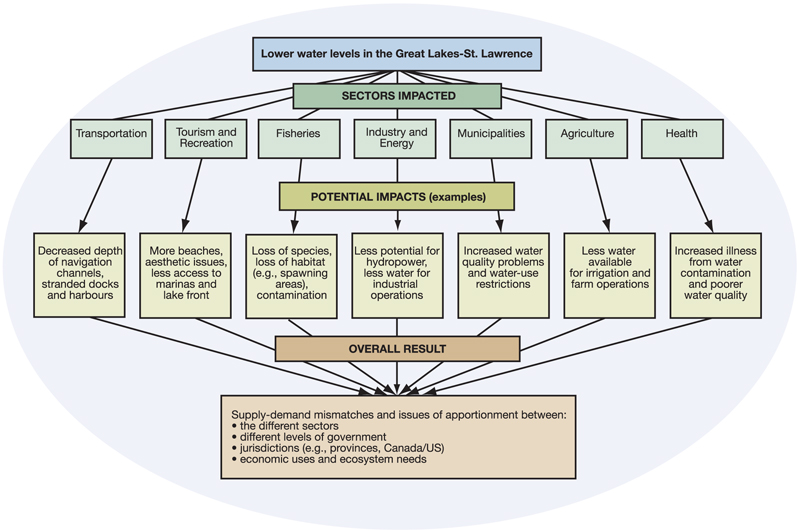FUTURE DIRECTIONS
(Canada in a Changing Climate)
Barriers to adaptation action need to be addressed, including limitations in awareness and availability of information and tools.
Although several examples of recent and ongoing adaptation
initiatives are highlighted in this assessment, the number of such actions is
small relative to the scope of adaptation needs. As the rate of climate change
increases, so does the urgency for adaptation action. Meeting this need will
require addressing some of the existing barriers to adaptation actions, such as
access to knowledge, data and decision-support tools; specific regulations or
legislation that may limit adaptation options; and societal expectation. Some
of these barriers to adaptation are jurisdiction or sector specific, involving
regulations or application of best practices. Other barriers crosscut regions
and sectors. These are best addressed through engagement of industry (including
business and professional organizations), community groups, individuals and all
orders of government, all of whom can serve as both facilitators and
implementers of adaptation actions. The crosscutting nature of climate change
impacts (Figure SR-6) is a challenge
in ensuring effective adaptation.
Moving forward on adaptation in Canada will involve building on the
momentum established by existing initiatives, and taking new steps to promote
and implement adaptation measures. Awareness-raising will be important for
overcoming some barriers to action. Many decision-makers need a clearer understanding
of the risks that climate change presents, and of the local and regional
benefits that adaptation provides. Mechanisms to enhance access to, and the
sharing of, knowledge and experience contained within industry, academia and
government would help to facilitate adaptation decision-making, as would the
development of tools to integrate climate change in planning and development
processes. Strategic approaches to adaptation would help maximize synergies and
reduce potential for conflict between and within sectors, industries and
regions. In some cases, decision-makers may choose to mandate and regulate
consideration of climate change adaptation within their programs and policies.

Figure
SR-6: The
crosscutting nature of climate impacts and adaptation, exemplified by lower
water levels in the Great Lakes–St. Lawrence basin. Adaptation decisions in one
sector will have significant consequences in several other sectors (Lemmen and
Warren, 2004).
Although further research will help to reduce uncertainties
and to address specific knowledge gaps and adaptation planning needs, existing
knowledge is sufficient to start undertaking adaptation activities in most
situations.
The chapters of this assessment reveal several research
needs to support adaptation decision-making, including:
- quantitative economic analysis, including costs and benefits of impacts and of adaptation options;
- analyses of adaptation processes;
- enhanced climate and socioeconomic scenarios at spatial and temporal scales appropriate for impact assessment and adaptation decision-making, as well as understanding of uncertainty associated with those scenarios;
- improved understanding of thresholds within both natural and human systems, beyond which adaptation is either ineffective or prohibitively expensive; and
- development of methods and tools to assist mainstreaming of climate change adaptation into sectoral planning processes.
The need for more research and the associated scientific
uncertainties do not justify inaction. This is demonstrated by the fact that
there are numerous examples of anticipatory adaptation in Canada and
globally. Adaptation measures that focus on reducing vulnerability to both
current and future climate represent a logical first step that delivers
benefits regardless of the rate of future climate changes. For example,
adapting building and infrastructure design to reflect both recent climate
trends and future projections, implementing water and energy conservation
strategies to reduce demand, and reducing reliance on climate-sensitive sectors
through economic diversification are actions that will produce both short- and
long-term benefits, and enhance the resilience of communities and industry.
Adaptation is an ongoing process that requires greater
attention in Canada
and globally. In many cases, the responses needed to adapt to changing climate
can be accomplished through existing processes and operations. The urgency for
action depends on the vulnerability of the system, and the magnitude and
life-cycle of investments being made. For example, billions of dollars are
invested annually in Canada
in climate-sensitive infrastructure that must function effectively and safely
for many decades. Similarly, many industries and local governments are engaged
in development planning extending 20 to 50 years into the future. Recognition
that the climate of the future will differ from that of the present, and
designing resilient systems to accommodate ongoing change, will enhance the
value of these investments and the sustainability of development efforts.


